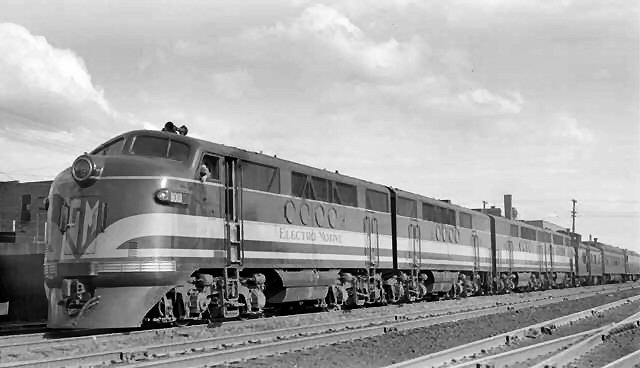- EMD FT
Infobox Locomotive
name=EMD FT
powertype=Diesel-electric
gauge=RailGauge|ussg

caption=EMD's FT demonstrator set #103, the locomotive that sold US railroads on the freight-hauling diesel locomotive.
builder=General Motors Electro-Motive Division (EMD)
buildmodel=FTA (cab unit), FTB (regular booster), and FTSB (short booster)
poweroutput=convert|2700|hp|abbr=on|lk=on for AB set
aarwheels=B-B (B-B+B-B for AB set)
builddate=November 1939 – November 1945
totalproduction=555A unit s, 541B unit s
locale=United States The EMD FT was a convert|1350|hp|sing=ondiesel-electric locomotive produced between November 1939, and November 1945, by General Motors' Electro-Motive Division (the "F" stood for "freight" and the "T" for convert|2700|hp with a two-unit set). All told 555 cab-equippedA unit s were built, along with 541 cabless boosterB unit s, for a grand total of 1,096 units. The locomotives were all sold to customers in theUnited States . It was the first model in EMD's very successful F-unit series ofcab unit freight diesels, and was the locomotive that convinced many U.S.railroad s that the diesel-electric freight locomotive was the future. Many rail historians consider the FT one of the most important locomotive models of all time.FTs were generally marketed as semi-permanently coupled A-B sets (a lead unit and a cabless booster connected by a solid drawbar) making a single locomotive of convert|2700|hp|abbr=on. Many railroads used pairs of these sets back to back to make up a four-unit A-B-B-A locomotive rated at convert|5400|hp|abbr=on. Some railroads purchased semi-permanently coupled A-B-A three-unit sets of convert|4050|hp|abbr=on, while a few, like the Santa Fe, ordered all their FTs with regular couplers on both ends of each unit for added flexibility. All units in a consist could be run from one cab;
multiple unit (MU) control systems linked the units together.Recognition and visual appearance
The FT is very similar to the later F-units in appearance, but there are some unique differences which render it distinguishable from later EMD freight cab units. The side panels of the FT were unique, but it was fairly common for railroads to alter that area to make an earlier unit appear later. As built, FT units had four porthole windows spaced closely together along their sides, and B units with couplers on both ends had a fifth window on one side for the
hostler position.The roof is a more reliable indication; FTs had four exhaust stacks along the centerline (flanked by boxy structures if
dynamic brake s were included). The radiator fans were recessed within the carbody, and arranged in two pairs, one near each end of the locomotive. Later units have the fans grouped together, and their shrouding extended atop the roof.The overhangs of the body past the trucks differ in the FT compared to later units. The B-units of FTs ordered in semi-permanently coupled A-B sets, and those with couplers on both ends, have a large overhang on one end (the coupler-equipped end on the paired units) featured on no other EMD B-units. This is not present on the B-units in semi-permanently coupled A-B-A sets, which were called "FTSB" units (for "Short Booster"). At other locations, except the cab front, the FT units have less of an overhang than later units; the trucks appear to be right at the ends of the car bodies.
Wartime restrictions
During
World War II , locomotive production was regulated by theWar Production Board . The traditional locomotive builders were prohibited from building diesel road locomotives until early 1945. There were a few dual-serviceALCO DL-109 s for the New Haven. Steam locomotives could be built with fewer precious resources, and were the proven commodity at the time.EMD however, was purely a diesel builder, and therefore was allowed to continue building diesel freight locomotives. The WPB assigned the FT's built to the railroads it deemed most able to benefit from the new locomotives. The Santa Fe received by far the largest allocation of them, given its heavy war traffic and the difficulty and expense of providing water for steam locomotives on its long desert stretches. The original A-B-B-A demonstrator set was sold to the Southern Railway.
Were it not for the wartime restrictions, many more FTs would have been built. Most railroads wanted diesels, but often had to settle for steam locomotives.
These wartime restrictions on other manufacturers' diesel programs helped ensure EMD's dominance of the postwar diesel market.
Subsequent models
The FT was discontinued in late 1945, replaced in production by the F2, which retained the convert|1350|hp|abbr=on rating of the FT, but with upgraded electrical and control equipment. The F2 was produced only in 1946, after which in turn it was replaced by updated models in the
EMD F-unit series, such as the F3, F7, and F9.Original buyers
Surviving units
Five EMD FT units survive today; they include the lead unit from demonstrator No. 103 displayed at the
Museum of Transportation inSt. Louis, Missouri ; an FT A unit, on display inMexico , which was originally built for theNorthern Pacific Railway ; and three B-units from the Southern Railway, and one of the two original FT B-units from the EMD 103 demonstrator set, at theVirginia Museum of Transportation .References
*
* Abbey, Wally. (2001) " [http://utahrails.net/drgw/emc-ft.php EMC and EMD FTs (especially ATSF)] ". Retrieved onDecember 26 ,2004 .
*
* Santa Fe Historical & Modeling Society. " [http://www.atsfrr.com/resources/funits/ft.htm Santa Fe Freight FT's] ". Retrieved onDecember 26 ,2004 .
Wikimedia Foundation. 2010.
